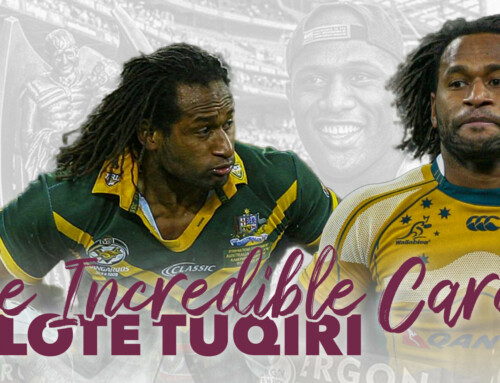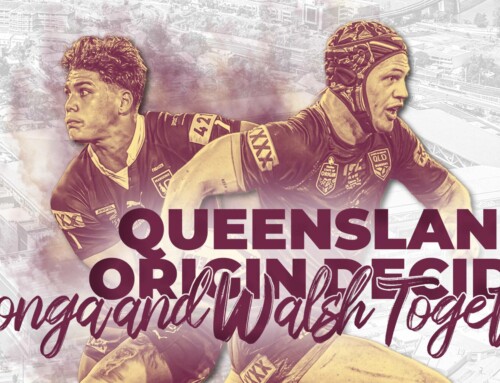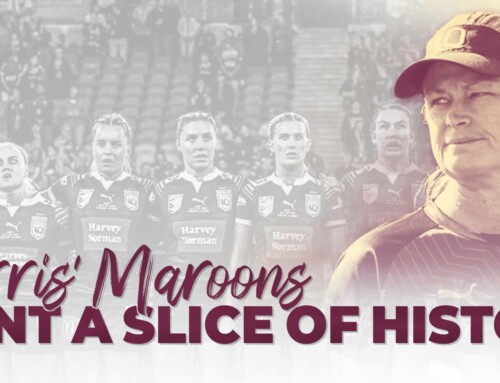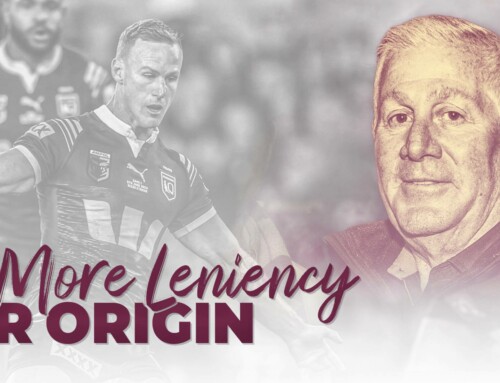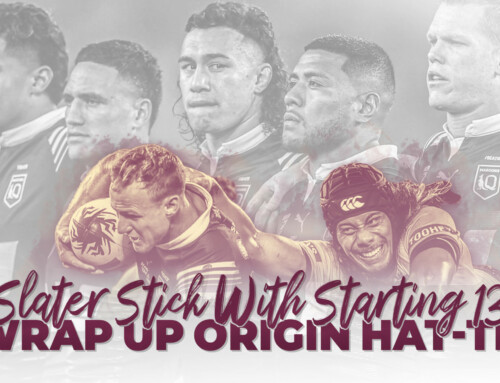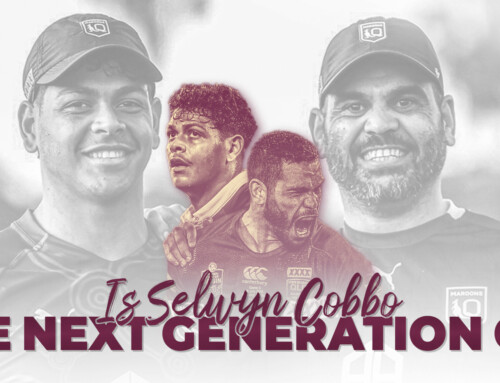By Wayne Heming
A bold gamble to head to the UK with a few dollars in his wallet and back himself to elevate his game to a new level was the making of a young Tonie Currie.
In this expansive interview, FOG # 31 admits he was naïve as a young player, falling into the trap of thinking it would just happen for him easily.
It didn’t.
Currie discovered in the UK he had to work a lot harder than ever on his game.
He applied himself to getting fitter, faster, and stronger so he could handle whatever came his way.
When Currie called it quits, due to a spate of injuries that beset his body, he had two premierships with two different teams, Canterbury (1988) and Brisbane (1992), and a World Club Championship with Brisbane to show for his efforts.
He was also voted Brisbane’s Rothman’s player-of-the-year in 1982 and claimed Lead’s player-of- the-year in 1986.
All up he played more than 200 games in the NRL and the UK Super League as well as 15 Origins for Queensland and seven Tests for Australia.
Not a bad rugby league resume at all.
We recently caught up with Tony who was more than happy to talk about his career, including sharing a story of how super coach Wayne Bennett looked after him toward the end of his career when he thought he was too busted to keep playing.
Q: Not too many people would know that you marked up on Wally Lewis in an Origin trial game in 1987 at Lang Park. Did you dust him up that day?
Currie: We beat them, I think we won 20-10, so yeah I can claim a victory over the King. Back then we played a couple of trials and I think it helped getting a bigger base of players together to get to know each other so it made it easier for players to transition into Origin football. I remember meeting all the boys back then, and we just gelled and we had that “us against them mentality”.
Q: That particular trial had a bit of selection controversy with a little blonde-haired lad from Ipswich named Allan Langer being handed his debut.
Currie: Alfie played in the Queensland-based Maroons. Laurie Spina was our halfback in the trial and if I remember rightly he played a pretty good game that night. The Queensland selectors though decided to go with Alf. Some years earlier I made the final of the Commonwealth Bank’s ball passing competition while I was still at High School. One of the other finalists was Alfie’s brother, Kevin and a rugby union player who ultimately won because he was throwing those spiral passes through the centre of the target. We ended up winning a pair of Bogart jeans and we had to dash from Mount-Cootha studios into the city to get fitted for our jeans. Kevin brought his little brother, Allan, with him and it was the first time I met him. I ended up playing with both of them. They were funny little fellas. I remember asking them how they got down to Brisbane and they said they got the “rattler” to Milton and a bus to Mount-Cootha. The ironic thing about that is when Alfie made his Test debut for Australia against PNG, I was his roomie. I was also in the Queensland team when Alfie debuted in 1987.
Q: There were reports that some were concerned that Alfie needed to be protected in defence because of his size prior to his Origin debut.
Currie: Any Queensland side I was involved in, I never heard that type of talk. We accepted everybody. We had players from the NSW competition who probably weren’t playing their best, but we all knew when they came into camp would go the extra mile, because they felt they had to honour the players before them. We never, ever had that feeling of “he’s not up to it” we were just totally immersed in trying to beat the Blues, that never came into the equation.
Q: Can you see Alfie becoming an immortal?
Currie: I hope so, he deserves it when you look at his playing record. Alfie was blessed to arrive at a time when Queensland was dominating or starting to dominate with such a really good nucleus of players. If you look at the 1987-88-89 teams there were not many changes as opposed to NSW who were picking everyone.
Q: You played in two grand final winning sides, Canterbury Bulldogs in 1988 and later in Brisbane’s 1992 grand final victory so you did pretty well?
Curries: It’s funny, I just got back from Canterbury’s 1988 grand final reunion in Sydney and we had almost 30 guys from the group that were involved in that grand final. The only blokes missing were Steve Mortimer, who sadly is not too well, and Steve Folkes who has passed away. Apart from that, we had the whole grand final side and every reserve that sat on the bench that day. Back in1988 nobody gave us much of a chance of winning. We were up against a great Canberra side that could have made the GF, Balmain, who unleashed a magical run to get to the grand final and Manly was right up there, there were some great teams. Gus Gould (coach) asked me at the reunion if I ever thought we were going to win the grand final. I said: “Gus, I was flat out getting through every week. One week I’d have Mal Meninga, the next week I’d have Michael O’Connor, the next, I’d have Andrew Ettingshausen and then Greg Florimo, All I was thinking of was getting over my opposing player”. Every week was a battle it was such a great competition.
Q: You played every backline position from five-eighth to fullback, what was your preferred spot?
Currie: I preferred centre. My stint at Leeds playing in the centres allowed me to hone my craft, that was a turning point for me being so young getting on a pane at 24, still a bit naïve and going over to England. I was going to play for Wigan originally, but the deal fell through after Alex Murphy got the chop. I went over for match fees, no sign-on, no contract. From memory, I was on 300 pounds a game, win, lose or draw and that’s what I had to survive on. If you were playing say Wigan and it was a championship game at Headingly maybe you’d get 1000 pounds, but if we lost Id still get my 300 pounds. I ended up playing five seasons in a row with no off-season. I played for Wests (1984), jumped on a plane did Leeds 84-85, came back, played nine games for Redcliffe, back on the plane to finish up with Leeds, came back to Wests in 1986 and moved to Canterbury Bankstown halfway through the season. The first year I went there we had Eric Grothe, Neil Hunt, Terry Webb, Wally Fullerton-Smith, Gavin Jones, Trevor Patterson, and Steve Bleakley. We were stacked with Aussies in a period where English fans were mesmerised by the unbeatable Kangaroo Tours. In my second year, they changed the rules, and clubs were only allowed two imports and Leeds kept me and Cliffy Lyons. I ended up playing 68 games for them, scoring 38 tries and being their player of the year in 1986 so I had a great time. I honestly believe that experience (Leeds) made me pull my head in. As a younger player I was a little blase about the game because I thought it would come easy.
Q: How did you find going to the big smoke of Sydney to play in the mid-1980s?
Currie: When I first went to Sydney in 1986, nobody knew me, none of the Sydney teams knew much about me or the style I had.I brought a bit of pace to the Canterbury backline. We made the final that year in the semifinal against Souths I got man-of-the-match, The next game we played Parramatta for the right to be the first side into the grand final. In the second half I went to back up a Terry Lamb break and I felt my hamstring go but “Baba” passed me the ball anyway and Ray Price cleaned me up in one his ferocious bloody tackles, the bastard (laughing) and I popped a rib cartilage. I had a popped rib cartilage and a torn hamstring and our coach Warren Ryan said me: “get right, get right, we need you”. I had a fitness Test on the eve of the grand final but failed it and Phil Sigsworth who had trained with the team all week got the call-up. I sat on the bench in jumper #26 which I still have. We all know the story, 4-2 Parramatta win, the swansong for both Price and Mick Cronin.
Q: Q: You sat out the 1986 GF with the Dogs injured but paid them back in 1988 only to leave the club and link with Wayne Bennett at the Broncos in 1989, how did that come about?
Currie: Look, Wayne was the Queensland coach in 1988. After one of our video sessions I just said to him casually: “. Hey Wayne, would you be looking for a centre next year? He said: “Certainly”. After everyone had left the room Wayne said: “We’d love to have you TC. The problem was I had already played for Australia and I had a $50,000 transfer fee on my head to the Dogs. In those days a Test player would command $100,000. Wayne said straight up the club couldn’t pay that. He said Brisbane would have to pay the Bulldogs $50,000 so I ended up telling Wayne I’d play with the Broncos for $50,000. At the time I was in camp with the Australian team staying at Camperdown and I snuck out to sign my NRL contract with Broncos boss John Ribot at a pub just around the corner. When I returned to the team hotel, Canterbury power broker, Peter “Bullfrog” Moore, who was the manager of the Kangaroo team, was around the bar and he said: “here’s my little Bulldog”, not knowing his little Bulldog had just become a Bronco. As it turned out the Bulldogs were still negotiating with me and I wanted to find out what I was worth. We had a meeting at a Chinese restaurant in Bankstown and Bullfrog offered me $50,000 to stay at the Bulldogs. Don’t forget, I’d already signed with Brisbane. I had a budding young player-manager with me at the time, Wayne Beavis, and he chirped up and said: quite frankly Peter, I think the lad is worth more. Peter takes one bite of his dim sim, looks at me and says: “$95,000”. That was what Terry Lamb and Steve Mortimer were on. I had to give him an answer so he drove around to my house in his blue Mercedes and I was waiting for him at the gate. He got out his car with this big smile on his face expecting to sign me up and I said: “Peter, I am going back to Brisbane.” He was so dirty with me he got to his car and said to me: “You know you’ll never play for Australia again.” I was fretting and worried if he had that much power so I called Wayne Bennett and told him what Moore had told me. Wayne assured me I had nothing to worry about and to go to bed and I did. Peter was cranky for some weeks but eventually he thanked me for my service to the Bulldogs.
Q: You were coached by some greats, Warren, Ryan, Wayne Bennett, Gus Gould, Arthur Beetson.
Currie: I was really lucky mate. You take as much as you can out of every coach, some a little more than others, some gel with you, some don’t. I didn’t gel with Warren Ryan but I’d rate him as one of the best coaches I ever had. Phil Gould was something else. At 29 years of age to win a grand final, hell he is only four years older than me and he did that. Ridiculous. Wayne was a totally different beast, different personality but a remarkable man and a great coach. I asked Wayne once why he always left our team celebrations early and his response was: “Because I don’t want to see what you become after midnight”. I asked Gould the same question why he stayed with his players until the very end and his response was: “because I want to get the truth”. Gus always felt that when players got into the alcohol; they’d tell him exactly what they thought.
Q: So how was Bennett to deal with from your perspective?
Currie: He was great, I owed Wayne a lot. I signed a three-year deal with the Broncos to come home and I snapped an Achilles tendon and did my medial ligaments, I also had a shoulder reconstruction. By the end of the deal in 1991, I was pretty smashed up and not the player I was when I signed for three years. Ribot called me into his office one day, and he looked at me and says: “TC we are going to sign you for one more year.” I said Ribes “I’m no good, I’m broken down”. Ribot said to me because you were willing to take took unders (less money) to come home, Wayne wants us to reward you.” Brisbane ended up giving me the most contract money I’d ever had in my final year. As a result, I ended up playing in the 1992 grand final win. Most people think Wayne is a “hard-ass bastard” but I can tell you he doesn’t forget.



